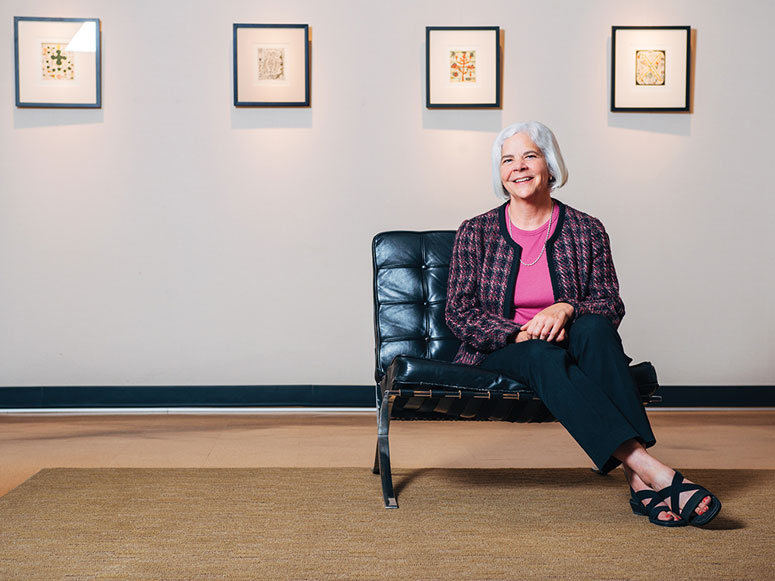
Dean of IIT Lewis College of Human Sciences
Photo by: Bonnie Robinson
Christine Himes’s path to dean of IIT Lewis College of Human Sciences was a wild ride—unpredictable, nonlinear, and filled with surprising twists. Over the course of her life, Himes has found one constant: pursuing her fascinations, no matter how circuitous and rudderless her career journey sometimes has seemed. She has taken risks and exemplified other qualities noted in highly creative individuals, seeking out new experiences and connecting the dots in seemingly unrelated situations, as she has followed her interests—and discovered her passions.
“Fear of failure, I think, is the biggest stumbling block to creativity. Sometimes young people can be more creative because they’re less afraid of making a mistake.”
One of eight children, the Chesterton, Ind., native says that she was a good student in high school but did not receive much guidance about how to choose a college or a course of study. She thought she might want to apply to law school or medical school one day and, liking science, chose chemistry as her major. She instead graduated from Purdue University with a B.A. in Russian language and a B.S. in industrial management, the latter because she was interested in economics. After working as a purchasing agent for a cereal toy packager and as a fiscal analyst for the Indiana General Assembly, Himes entered into a graduate mathematics program.
While at Purdue, Himes saw a promotional poster about demography and decided to enroll in one of the few demography doctoral programs in the country at that time, at the University of Pennsylvania, which “turned out to be the perfect fit.” With a second doctorate in sociology, Himes embarked on a 19-year career at Syracuse University, where she served as chair and Maxwell Professor of Sociology as well as director of the Center for Policy Research at the Maxwell School of Citizenship and Public Affairs. At the center, Himes fostered a creative environment through interdisciplinary collaboration and contributed to the establishment of the Aging Studies Institute.
The daughter of a retired electrical engineer and the mother of an aerospace engineer, Himes says that she already “feels very much at home” at IIT. She shares some thoughts about creativity here and in an IIT Magazine Video Extra at iit.edu/magazine discusses how the intersection of humanities and technology can inspire creativity.
What drew you to apply for the dean position at IIT?
I was attracted to apply because this is a new college. I like the fact that it is interdisciplinary almost by nature. Gerontology and demography, my two areas of study, are both interdisciplinary. I like the size of IIT, which allows people to do more creative things. You can go right over and talk to the person because there aren’t as many layers of bureaucracy as found at larger institutions.
I also like the idea of emphasizing the social and the behavioral sciences within a technology environment. We spend a lot of time thinking about how to train people to develop new technology; we have to spend some time thinking about what the implications of that technology are on our lives. How can technology be a useful tool to us?
The combination of identifying what societal problems we want to address and drawing upon technology as a way to solve those problems is our future.
Can creativity be taught?
To be creative, one needs certain tools and skills, which can certainly be taught. People can be taught to think differently; that’s the way to come up with new solutions. But can you teach someone to have a particular way of thinking? I don’t think so. You can’t change people’s underlying tendencies toward what they’re good at or the way that they think, but you can give them skills that will allow them to tap into the parts of their brain that they may not always use.
What are some creativity landmines?
Fear of failure, I think, is the biggest stumbling block to creativity. Sometimes young people can be more creative because they’re less afraid of making a mistake. Another stumbling block is that people have ideas but don’t know what to do with them. People are much more creative than we know, but they don’t have a good way of communicating those ideas or putting them into practice. Another set of skills is required to make ideas known and meaningful. Establishing environments such as IIT’s new innovation center and business incubators where creativity can flourish is important.
How do we foster creative leadership?
We need to reward people for doing things that are different. Traditionally, academia is very narrow, with people sometimes existing in silos; there isn’t a very good system in place for encouraging people to be interdisciplinary or multidisciplinary. If we’re going to talk about getting our students to be collaborative, we have to be able to do that at our level, too, and show how that works. We need to create an administrative structure that makes it easy for people to do that. We need to set good examples.